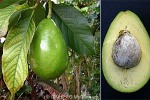Cook Islands Biodiversity Database
Species Page
Persea americana
‘ĀpukaAvocado
Multimedia & Additional Resources
| Type | Description | Download |
| Leaves, fruit and flowers | 54KB |
General Information
Cook Islands Distribution
| Southern Group: Present Makatea: Present | ||||||||
RR |
MG |
AT |
MK |
MT |
AK |
PL |
TK |
MN |
++++ |
++ |
+++ |
++ |
+++ |
- |
- |
||
| Northern Group: Present | |||||
TN |
MH |
RK |
PK |
NS |
SW |
- |
+ |
- |
- |
- |
- |
Scientific Taxonomy
Persea americana Mill.
SYNONYMS: Persea gratissima [incl. TC]; Laurus
TAXONOMY: PLANTAE; ANTHOPHYTA (=Angiospermae); MAGNOLIOPSIDA (=Dicotyledones); MAGNOLIIDAE; Laurales; LAURACEAE
More Information
SIGNIFICANCE NOTES -. Comment: NBSAP - Atiu (4 of 5 domestic)
POSITIVE SIGNIFICANCE: Food (Fruit 4+) Export. Comments: The flesh has a nutty flavour and high oil content (~25%). The oils/fats are mainly monounsaturated (17% sat., 66% monounsat., 17% polyunsat.), and it contains NO cholesterol. It is rich in vitamins (folacin, vit. A, B6, and C) and minerals (K). And beta-sitosterol which reduces cholesterol absorption. Eaten raw, often in salad, or as a spread on bread, hence "poor-man's butter'; and it is a principal ingredient in guacamole, a Mexican sauce.
IDENTIFICATION: Much-branching tree to 15m. LEAVES terminal clusters, alternate, wide-oval, to 30x15cm, dark green above, margins smooth; stalk 5cm. FLOWERS dense clusters, small, 15mmØ, without petals. FRUIT several dinstinctive varieties, usually pear-shaped or oval, skin smooth, ripening green to purple; flesh green to yellow, buttery. SEED single, large.
GENERAL NOTE: Avocado was cultivated by the native Americans in Peru from at least 750BC, and presumably earlier in Mexico where the tree is native. The name Avocado comes from the Spanish Aquacate which is from Aztec Ahuacacuauhitl, meaning 'testicle tree'. It was thought to have aphrodisiac qualities, and this may have been the reason by it was not planted in the Spanish missions in the Americas.
Introduced to Rarotonga from Tahiti in the 1870s [Cheeseman]. And had been introduced to Tahiti in 1846 by Admiral Hamelin. In Hawaii by 1825 on Bloxam [misnomer: Andrew Bloxam was on HMS Blonde] from Rio de Janeiro, or slightly earlier by Spanish settler Don Marin [Wagner et.al.]. Probably introduced to Fiji in the 1880s [A.C.Smith, Flora].
Avocado is used in salads, and is also a butter substitute because it is rich in fats. It is a good source of vitamin E, potassium, the antioxidant oleic acid, and dietary fibre. It also contains folic acid and vitamin B6.
Although it contains 15% fats, they are mostly heart-friendly fats. The 5 grams of fat in a 30 gram serving are: 3 g of monounsaturated fat and 1g polyunsaturated fat which are both heart-friendly by lowering your dangerous LDL cholesterol and raising your beneficial HDL cholesterol; the 1g of saturated fat is heart-unfriendly. As a heart-friendliness spread for bread and toast, avocado is a little better than sour cream, much better than cream cheese and immeasurably better than butter.
In addition, compared to most fruits avocado is high in a phytosterol (beta-sitosterol) and an anti-oxidant (glutathione): the first is linked to reduced cholesterol absorption through the gut wall, and the second is linked to a reduction on some types of cancers.
Vouchers & References
Vouchers:
None Recorded.
References:
p.847 Wagner et al.- Flowering Plants of Hawaii
p.363 Neal - In Gardens of Hawaii
p.848 Hortus 3rd
p.866 Royal Hort. Soc. Index of Garden Plants
p.463 Tropica
p.2/115 A.C.Smith - Flora Vitiensis Nova
p.293 R* Cheeseman - Flora of Rarotonga
p.51 Wilder - Flora of Rarotonga
p.357b Whistler - Ethnobotany of the Cook Islands
p.18 McCormack/Kunzle - Rarotonga's Mountain Tracks and Plants
Data Update History (information):
zTX, zB02, zM02, zD02
Web Resources
Citation Information
McCormack, Gerald (2007) Cook Islands Biodiversity Database, Version 2007.2. Cook Islands Natural Heritage Trust, Rarotonga. Online at http://cookislands.bishopmuseum.org. ![]()
Please refer to our use policy.

